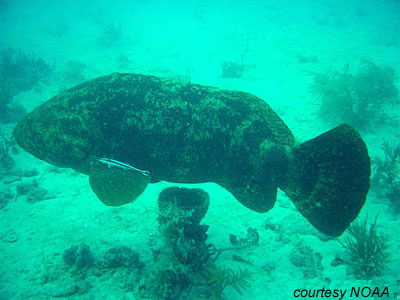
Epinephelus itajara
This large, solitary fish will defend its territory when threatened, with aggressive body language and a rumbling sound it makes with its swim bladder. Its large, thick, elongated body can grow to over 8 feet long (and up to 800 pounds), from rounded snout and small eyes, to short, fan-like tail fin. Usually it is a mottled yellow-brown to grey with darker bard and spots, ideal for blending in to their rocky coral and muddy inshore habitat. Although most groupers start out as females and become males later in life, there is still some debate as to goliath groupers being protogynous hermaphrodites.
Order: Perciformes
Family: Serranidae
Genus: Epinephelus
Species: itajara
Common Names
English language common names include goliath grouper, jewfish, blackbass, esonue grouper, giant seabass, grouper, hamlet, southern jewfish, and spotted jewfish. Other names are badejo (Portuguese), camapu (Portuguese), cernia gigante (Italian), cherna (Spanish), garoupa (Portuguese), gran morgoe (Sranan), guasa (Spanish), hata (Japanese), havabbor (Norwegian), havsabborre (Swedish), itajara zmienna (Polish), judefisk (Norwegian), mero guasa (Spanish), merou (French), orfoz (Turkish), raitameriahven (Finnish), rophós (Greek), sciarrano (Italian), tipa (Palicur), vartari (Icelandic), and zackenbarsch (German).
Importance to Humans
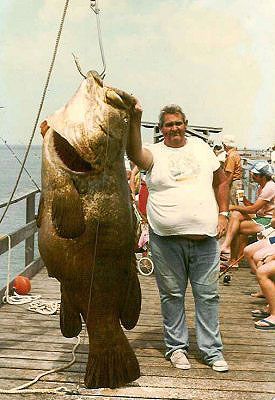
Of historical importance to commercial fisheries, the goliath grouper has also long been prized by recreational and sport fishers. Traditionally, the species has been caught primarily by hook and line, traps, and trawls. Spear fishers find this fish easy to approach; hence in locations accessible to divers their numbers have declined. The flesh is of excellent quality.
Danger to Humans
Very large goliath grouper have been observed to stalk divers and even conduct unsuccessful ambushes of the same. Large individuals of this species should be treated with caution.
Conservation
The large size, slow growth, low reproductive rate, and spawning behavior have made the goliath grouper especially susceptible to overfishing. The goliath grouper is totally protected from harvest and is recognized as a “Critically Endangered” species by the World Conservation Union (IUCN). Furthermore, the IUCN concludes that the species has been “observed, estimated, inferred or suspected” of a reduction of at least 80% over the last 10 years or three generations.
> Check the status of the goliath grouper at the IUCN website.
In U.S. waters, take of this species has been prohibited since 1990, and the species has been protected in the Caribbean since 1993. Historical exploitation of goliath grouper annual spawning aggregation sites greatly reduced the number of reproductive adults. As goliath grouper are slow growing and require several years to reach sexual maturity, recovery for this species is expected to be slow.
> Download the NOAA Technical Report on the goliath grouper and related Nassau grouper.
Geographical Distribution
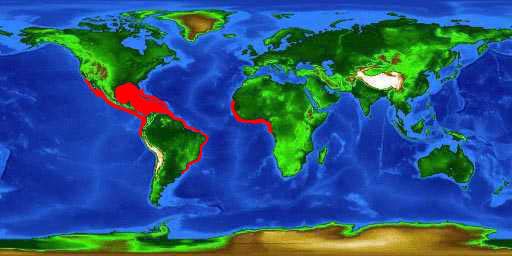
The goliath grouper occurs in the western Atlantic Ocean from Florida south to Brazil, including the Gulf of Mexico and the Caribbean Sea. It is also found in the eastern Atlantic Ocean, from Senegal to Congo although rare in the Canary Islands. The species is also present in the eastern Pacific Ocean from the Gulf of California to Peru.
Habitat
Occurring in shallow, inshore waters to depths of 150 feet (46 m), the goliath grouper prefers areas of rock, coral, and mud bottoms. Strikingly patterned juveniles inhabit mangroves and brackish estuaries, especially near oyster bars. The goliath grouper is notable as one of the few groupers found in brackish waters. This fish is solitary by nature, with the adults occupying limited home ranges. It is territorial near areas of refuge such as caves, wrecks, and ledges, displaying an open mouth and quivering body to intruders. Additional warning may be delivered in the form of the goliath grouper’s ability to produce a distinctly audible rumbling sound generated by the muscular contraction of the swim bladder. This sound travels great distances underwater and is also used to locate other goliath grouper.
Biology
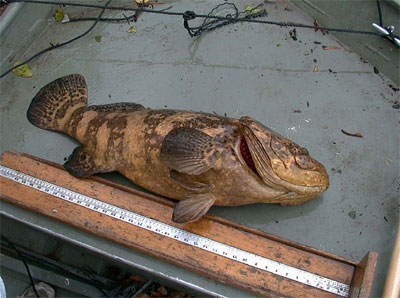
Distinctive Features
Goliath grouper are the largest members of the sea bass family in the Atlantic Ocean. The body is robust and elongate; its widest point is more than half its total length. The head is broad with small eyes. The dorsal fins are continuous with the rays of the soft dorsal longer than the spines of the first dorsal fin. The membranes between the dorsal fin elements are notched. Pectoral fins are rounded and noticeably larger than the pelvic fins. Bases of the soft dorsal and anal fins are covered with scales and thick skin. The caudal fin is rounded.
Coloration
This fish is generally brownish yellow, gray, or olive with small dark spots on head, body, and fins. Large adults are somber-colored. Three or four irregular faint vertical bars are present of the sides of individuals less than 3 feet (1m) in length. The rear half of the caudal penduncle of these small individuals is covered by another similar bar. The tawny colored juveniles, although not as colorful as some grouper species, are attractively patterned; exhibiting a series of dark, irregular, vertical bands and blotches.
Dentition
Goliath grouper have three to five rows of teeth in the lower jaw. The presence of a number of short weakly developed canine teeth is useful in distinguishing this species from other North Atlantic groupers.
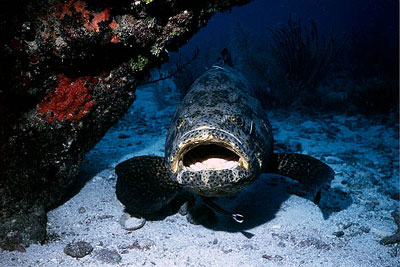
Size, Age, and Growth
The goliath grouper is the largest grouper in the western Atlantic. Growing to lengths of 8.2 feet (2.5 m), this grouper can weigh as much as 800 pounds (363 kg). In Florida, the largest hook and line captured specimen weighed 680 pounds (309 kg).
The oldest verifiable goliath grouper on record is 37 years. However, this specimen was sampled from a population of individuals depressed by fishing pressure and it is projected that goliath grouper may live much longer, perhaps as much as 50 years. Males achieve sexual maturity at four to six years of age and lengths of 43-45 inches (110-115 cm), females at six to seven years of age and 47-53 inches (120-135 cm). Growth rates are slow, averaging approximately four inches (10 cm) per year until the age of six years. Growth declines to about 1.2 inches (3 cm) per year at age 15, and less than .4 inches (1 cm) per year after 25 years.
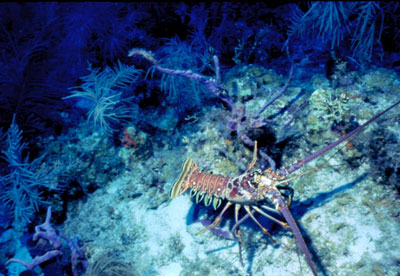
Food Habits
Goliath grouper feed largely on crustaceans (in particular spiny lobsters, shrimps and crabs), fishes (including stingrays and parrotfishes), octopus, and young sea turtles. Prey is ambushed, caught with a quick rush and snap of the jaws. The sharp teeth are adapted for seizing prey and preventing escape although most prey is simply engulfed and swallowed whole.
Reproduction
Many groupers are protogynous hermaphrodites – a condition in which individuals first mature as females only later to become males. And although goliath grouper are assumed to conform to this reproductive mode, a 1992 study of the age, growth, and reproduction of the species found no transitional individuals, the most direct evidence of sex reversal. However, the significance of this finding is of diminished value when one considers that transitional individuals are known to be rare amongst confirmed species of protogynous hermaphrodites, such as the red grouper (Epinephelus morio) and gag (Mycteroperca microlepis). Additionally, exceptions to the rule of protogyny within a species may be common. One author offers three potential exceptions that may explain why some sexually mature male goliath groupers are smaller than some mature females – a scenario that at first would seem to be contradictory for a protogynous hermaphrodite.
1) An individual’s failure to recognize certain environmental cues or the absence of those environmental cues altogether may mean that sex change is never initiated.
2) Some females may transition to the male condition prematurely, i.e., they never attain sexual maturity as a female.
3) The size at sex reversal may vary amongst populations.
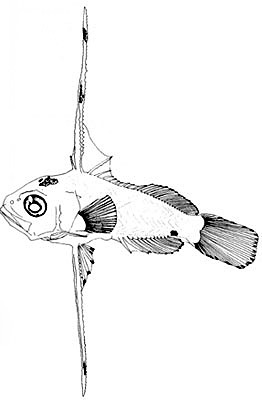
In support of the notion that the species is a protogynous hermaphrodite is the fact that the largest goliath groupers are invariably male.Spawning occurs during the summer months of July, August, and September throughout the goliath grouper’s range and is strongly influenced by the lunar cycle. Spawning goliath grouper form impressive offshore aggregations of up to 100 or more individuals. Ship wrecks, rock ledges, and isolated patch reefs are preferred spawning habitat. In the 1980’s these aggregations reached a low of less than 10 individuals per site as fishing pressure greatly impacted this species. Since receiving legislative protection the spawning aggregations of goliath grouper have risen to 20-40 individuals per location. The females release eggs while the males release sperm into the open offshore waters. After fertilization, the eggs are pelagic, dispersed by the water currents. Upon hatching, the larvae are kite-shaped, with the second dorsal-fin spine and pelvic fin spines greatly elongated. These pelagic larvae transform into benthic juveniles at lengths of one inch (2.5 cm), around 25 or 26 days after hatching.
Predators
Predators of groupers include large fish such as barracuda, king mackerel and moray eels, as well as other groupers. The sandbar shark (Carcharhinus plumbeus) and the great hammerhead shark (Sphyrna mokarran) are also known to feed on groupers. Large adults of this species likely have very few natural predators.
Taxonomy
The German ichthyologist M.H.C. Lichtenstein described the goliath grouper as Serranus itajara in an 1822 publication regarding the natural history of Brazil. In an 1884 work, “The fishes of the Florida Keys,” David Starr Jordan proposed the inclusion of the goliath grouper in Epinephelus (Bloch 1793) and this combination remains in use today. Of incidental note is the fact that various authors have incorrectly spelled the specific epithet “itajara” as “itaiara.” The genus name comes from the Greek epinephelos translated as cloudy. Synonyms of E. itajarainclude Serranus guasa Poey 1860 and Serranus quinquefasciatus Bocourt 1868. A number of authors treat the name Promicrops itajara as valid taxonomy for the goliath grouper.
Prepared by: Robert H. Robins